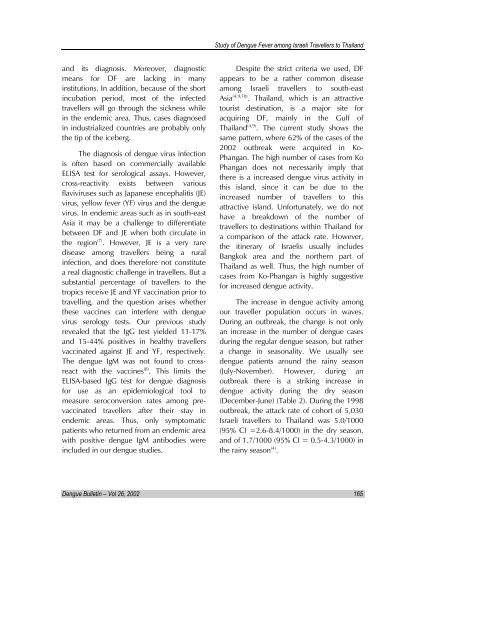Dengue Bulletin
Dengue Bulletin
Dengue Bulletin
- TAGS
- dengue
- bulletin
- 203.90.70.117
Create successful ePaper yourself
Turn your PDF publications into a flip-book with our unique Google optimized e-Paper software.
and its diagnosis. Moreover, diagnostic<br />
means for DF are lacking in many<br />
institutions. In addition, because of the short<br />
incubation period, most of the infected<br />
travellers will go through the sickness while<br />
in the endemic area. Thus, cases diagnosed<br />
in industrialized countries are probably only<br />
the tip of the iceberg.<br />
The diagnosis of dengue virus infection<br />
is often based on commercially available<br />
ELISA test for serological assays. However,<br />
cross-reactivity exists between various<br />
flaviviruses such as Japanese encephalitis (JE)<br />
virus, yellow fever (YF) virus and the dengue<br />
virus. In endemic areas such as in south-east<br />
Asia it may be a challenge to differentiate<br />
between DF and JE when both circulate in<br />
the region (7) . However, JE is a very rare<br />
disease among travellers being a rural<br />
infection, and does therefore not constitute<br />
a real diagnostic challenge in travellers. But a<br />
substantial percentage of travellers to the<br />
tropics receive JE and YF vaccination prior to<br />
travelling, and the question arises whether<br />
these vaccines can interfere with dengue<br />
virus serology tests. Our previous study<br />
revealed that the IgG test yielded 11-17%<br />
and 15-44% positives in healthy travellers<br />
vaccinated against JE and YF, respectively.<br />
The dengue IgM was not found to crossreact<br />
with the vaccines (8) . This limits the<br />
ELISA-based IgG test for dengue diagnosis<br />
for use as an epidemiological tool to<br />
measure seroconversion rates among prevaccinated<br />
travellers after their stay in<br />
endemic areas. Thus, only symptomatic<br />
patients who returned from an endemic area<br />
with positive dengue IgM antibodies were<br />
included in our dengue studies.<br />
Study of <strong>Dengue</strong> Fever among Israeli Travellers to Thailand<br />
Despite the strict criteria we used, DF<br />
appears to be a rather common disease<br />
among Israeli travellers to south-east<br />
Asia (4,9,10) . Thailand, which is an attractive<br />
tourist destination, is a major site for<br />
acquiring DF, mainly in the Gulf of<br />
Thailand (4,9) . The current study shows the<br />
same pattern, where 62% of the cases of the<br />
2002 outbreak were acquired in Ko-<br />
Phangan. The high number of cases from Ko<br />
Phangan does not necessarily imply that<br />
there is a increased dengue virus activity in<br />
this island, since it can be due to the<br />
increased number of travellers to this<br />
attractive island. Unfortunately, we do not<br />
have a breakdown of the number of<br />
travellers to destinations within Thailand for<br />
a comparison of the attack rate. However,<br />
the itinerary of Israelis usually includes<br />
Bangkok area and the northern part of<br />
Thailand as well. Thus, the high number of<br />
cases from Ko-Phangan is highly suggestive<br />
for increased dengue activity.<br />
The increase in dengue activity among<br />
our traveller population occurs in waves.<br />
During an outbreak, the change is not only<br />
an increase in the number of dengue cases<br />
during the regular dengue season, but rather<br />
a change in seasonality. We usually see<br />
dengue patients around the rainy season<br />
(July-November). However, during an<br />
outbreak there is a striking increase in<br />
dengue activity during the dry season<br />
(December-June) (Table 2). During the 1998<br />
outbreak, the attack rate of cohort of 5,030<br />
Israeli travellers to Thailand was 5.0/1000<br />
(95% CI =2.6-8.4/1000) in the dry season,<br />
and of 1.7/1000 (95% CI = 0.5-4.3/1000) in<br />
the rainy season (4) .<br />
<strong>Dengue</strong> <strong>Bulletin</strong> – Vol 26, 2002 165









